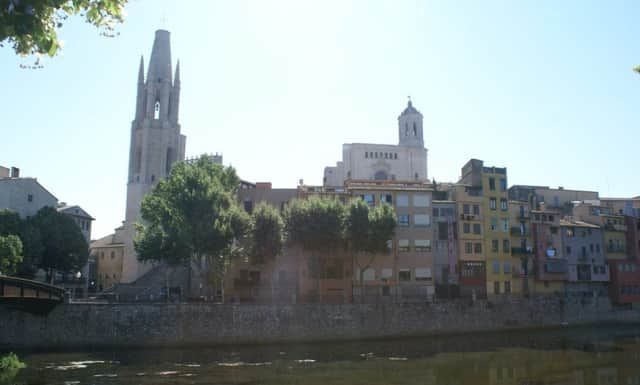Beautiful Catalan city of Girona has more than a few links with Ireland


I visited the Catalonian city of Girona recently and quickly enhanced its already-familiar name with over 2,000 years of extraordinary history and culture.
Woven between soaring monuments to the city’s past - the majestic Catedral de Girona; the curiously curtailed steeple on Basilica de Saint Feliu; the fossil-encrusted Roman walls - small, picturesque squares, cobbled alleys and narrow, stone-stepped lanes pattern the hillside along the River Onyar.
Advertisement
Hide AdAdvertisement
Hide AdThe earliest known photograph of Girona, dating from around 1852 and preserved in the National Library of Ireland is a view of the Onyar.
The Pont (bridge) de Sant Feliu is one of the main crossings to the old city, offering a curious introduction to its wealth of intrigue.
La Lleona is a carved lioness climbing a stone column, a copy of a 12th-century sculpture housed in the Art Museum.
Tradition dictates that good citizens or courteous visitors kiss the animal’s chiselled posterior!
Advertisement
Hide AdAdvertisement
Hide AdRoamer hastily broke with tradition, choosing instead to wonder at the incomplete Gothic tower above the magnificent Basilica de Saint Feliu.
The landmark building, begun around the year 1200 and completed in the early 17th-century, lacks the top half of its steeple!
“It was either too heavy, too expensive or lightning,” my guide speculated.
Large stone-sculpted flies adorned a nearby façade.
Smiling widely, the guide recounted ‘the miracle of the flies’, said to have first occurred when the King of France besieged Girona around 1286.
Advertisement
Hide AdAdvertisement
Hide AdThe city surrendered without a fight but the French ransacked Girona, vandalising the body of Patron Saint Narcís in the church of Saint Feliu.
Huge flies emerged from the Patron Saint, biting and killing the marauding Frenchmen and their horses.
The foreign intruders were similarly bugged on several occasions thereafter and (unnervingly lifelike) stone reminders aren’t uncommon.
There’s an unlikely Irish link with the Catedral de Girona.
The iconic building boasts the widest Gothic nave in the world (23 metres) and while there are easier ways to gain access to the soaring, sculpted interior, many visitors choose to climb the steep, 90-step, stone staircase to reach the main entrance.
Advertisement
Hide AdAdvertisement
Hide AdLast year two Vietnamese circus-performing brothers made it into the Guinness Book of World Records by scaling the steps in just 52 seconds, one balanced upside-down on top of the other with only head-to-head contact.
The staircase dates from the late 17th century; the awesome main façade is Baroque, and the cloister, paved with ancient tombstones, dates from the 12th century.
The Cathedral’s high altar-screen, made of silver, enamel and precious stones, is one of the jewels of Spanish precious metalwork.
The capitals in the cloister bear ancient, hallowed, sculpted scenes from the Old and New Testaments and the tapestry of the Creation is an important piece of priceless Romanesque.
Advertisement
Hide AdAdvertisement
Hide Ad“They’re not doors, they’re windows,” explained my guide as we scaled steeply undulating steps in the narrow, overshadowed alleys of the Jewish quarter.
Centuries of resurfacing have raised the winding pathways high above their original levels, and the old stone windowsills are today’s doorsteps.
The Jewish Quarter (or Call Jueu), with its magnificent museum, is one of the city’s most emblematic areas.
The labyrinth of narrow streets and patios have maintained a truly medieval ambiance, making it one of the best preserved Jewish quarters in the world.
Advertisement
Hide AdAdvertisement
Hide AdJews who wouldn’t convert to Christianity were expelled from Girona in 1492.
Many came to Ireland!
One of the Jewish museum’s prized exhibits is the copy of an incredible world map called l’Atles de Cresques, produced in 1373.
Created by a map-making father and son, Ireland is incredibly distinguishable in shape and outline, though Lough Neagh is missing!
Situated in a former Capuchin convent, Girona’s Arabic Baths (El Banys Arabs) have been documented from the 12th century, though their date and origin is unknown.
Advertisement
Hide AdAdvertisement
Hide AdThe domed, intricately planned ‘bathing unit’ puts our modern shower to shame.
Its brilliantly preserved all-stone layout includes an apodyterium (changing room) behind the entrance door leading to an octagonal pool.
Double doors rendered the apodyterium watertight, guaranteeing dry clothes in the carved-stone lockers.
A frigidarium, or cold room, leads into the warm room, or tepidarium.
Near at hand is the caldarium, the hot steam baths.
Advertisement
Hide AdAdvertisement
Hide AdThe heat came from an oven via an underground source known as the hypocaust and was distributed via a built-in, glazed, carved-stone canal.
My short (six hours!) sojourn in Girona ended stunningly in the English-named Local Market restaurant where I cooked my own Catalonian feast tutored by two young and exuberant chefs who introduced themselves as Irene and Marion.
Born on the same day in the same year, the perfectly synchronised duo taught me in tandem to cook a true Catalonian potato tortilla.
They taught me well and I’ll never mash a spud again!
Roamer was in Costa Brava and Girona courtesy of Jet2.com and Jet2Holidays who fly directly to Girona from Belfast International Airport, with flights available twice weekly on Mondays and Wednesdays.
It is one of their 25 destinations that can currently be booked from Belfast.
For more information visit www.jet2.com or www.jet2holidays.com.